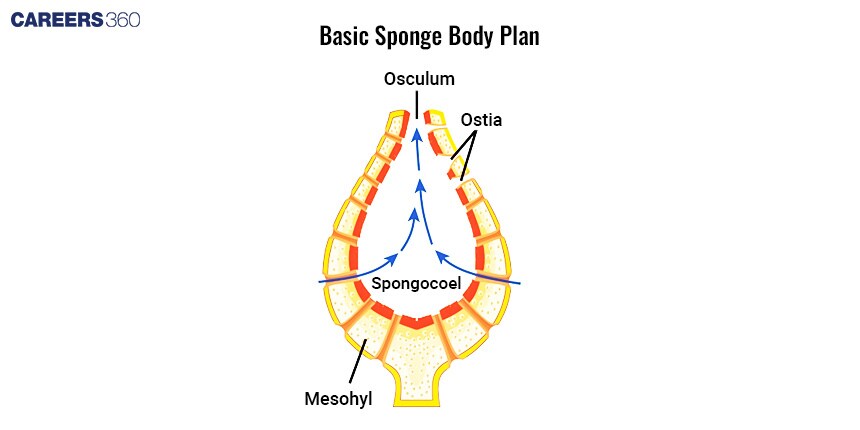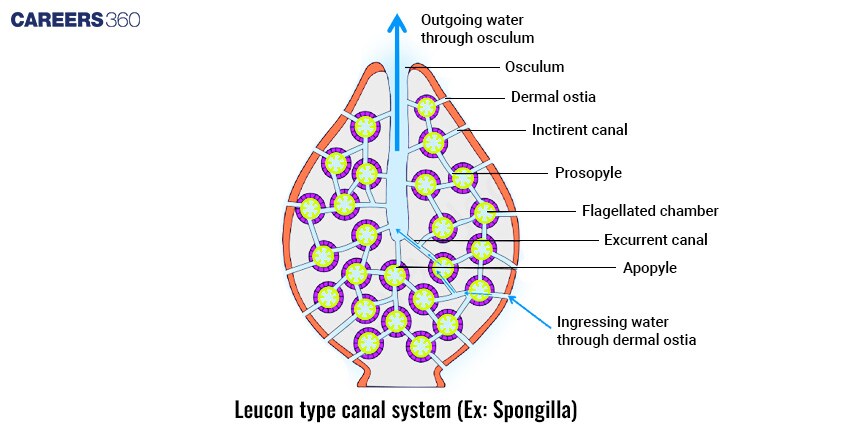Phylum Porifera: Characteristics, Examples, Topics, Structure, Classification
Phylum Porifera includes simple, sponge-like animals that live mostly in water and have porous bodies for filtering food and oxygen. This topic is from class 11 chapter Animal Kingdom in Biology. This article includes phylum Porifera class 11 definition, meaning, characteristics, classification, examples, notes and diagrams.
This Story also Contains
- Definition of Porifera
- Porifera Structure
- Classification of Phylum Porifera
- Examples of Phylum Porifera
- Habitat and Adaptations in Porifera
- General Characters of Phylum Porifera
- Recommended Video on Phylum Porifera
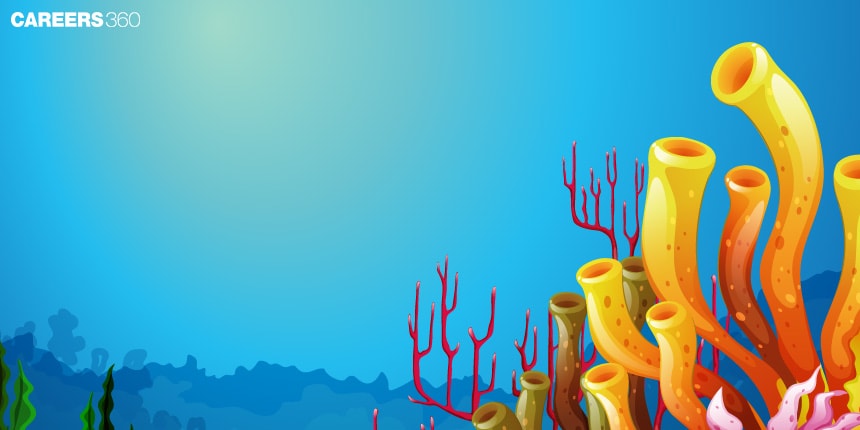
Definition of Porifera
Porifera represent the most primitive multicellular animals in the animal kingdom. Physically, they are marine animals, although some species thrive in freshwater. They get the name Porifera from the Latin "porus", meaning pore, and "ferre", to bear, references to their porous body structure.
Although Porifera represent simple, multicellular animals, because of their unique features in structural and functional adaptation, they play a vital role in aquatic ecosystems.
Also Read:
Porifera Structure
The body structure of Porifera, or sponges, is specially adapted to the aquatic way of life to enable filter feeding and other relations with environmental components.
External Morphology
Sponges range from simple shapes to complex, branching forms.
This can be affected by many environmental variables, such as water currents and substrate type.
They can have very smooth, rough, or even small surfaces through which water enters.
Some sponges form a hard external layer that protects them from predators and prevents environmental stress.
Internal Anatomy
Sponges have a simple internal structure with several specialised cell types performing distinct functions:
Choanocytes: Also known as collar cells, these line the internal chambers and canals. They have a central flagellum surrounded by a collar of microvilli.
Amoebocytes: These mobile cells reside within the mesohyl (a gelatinous matrix) and perform various functions, including digesting food particles captured by choanocytes, distributing nutrients, and differentiating into other cell types required for repair and growth.
Pinacocytes: These flat cells form the outer layer and can contract to regulate the size of the sponge's pores and oscula (excurrent openings).
Structural Components
Spicules are the rigid structural elements, either silica or calcium carbonate, that form a skeleton, providing support to the organism and giving protection against predators.
They are shape-varied, size-varied, and unique features in the classification of sponges.
Spongin fibres are very flexible and fibrous, being made of a protein much like collagen, called spongin.
This provides side support and elasticity to the sponge, helping it stand pressure from the surroundings.
Phylum Porifera Diagram
The diagram given below indicates the basic structure of a sponge animal body plan.
Classification of Phylum Porifera
The three main classes of Porifera are Calcarea, Demospongiae, and Hexactinellida.
Calcarea
The skeleton is composed of calcium carbonate spicules.
It is normally found in shallow marine conditions.
All types of body plans are represented, namely, asconoid, syconoid, and leuconoid.
Examples
Clathrina: This genus is regarded in most works as a simple, tubular representative of the Solenida.
Leucosolenia: The body shape is branching and tubular.
Demospongiae
This represents the largest and most diverse class, forming approximately 90% of all sponge species.
The spicules are made up of silica and/or spongin fibres, while in some, it is only the spongin.
The body design is majorly of the leuconoid type, enabling them to attain large size and complex shapes.
They inhabit almost all aquarium habitats, from shallow waters in coastal areas to deep-sea environments.
Examples
Spongilla: Freshwater sponges, spicules siliceous.
Euspongia Bath Sponge: Known commercially because of its soft spongin skeleton.
Hexactinellida
Also known as glass sponges due to the spicules being silicate-based and incorporated into a lattice structure.
Generally deep-sea animals.
The body does not contain individual cells, it contains a syncytium, meaning a single continuous mass of cytoplasm and many nuclei.
Mostly leuconoid body plan.
Examples
Euplectella: Venus' Flower Basket, is one of the more well-known demosponges due to its graceful, glassy shape.
Aphrocallistes: One of the more well-known demosponges due to its sturdy shape, which is tube or funnel-shaped.
Examples of Phylum Porifera
The phylum Porifera contains a wide range of species of sponges that will be found in diverse environments, from freshwater lakes to deep-sea environments.
Spongilla (Freshwater Sponge)
Found in freshwater, it inhabits lakes, rivers, and streams.
Spongilla has managed to adapt to freshwater by developing gemmules that aid in survival throughout such adverse conditions as freezing temperatures and desiccation.
Euspongia (Bath Sponge)
Mostly in warm, shallow marine waters.
It has a flexible, absorbent structure comprising spongin fibres that render this sponge commercially useable as natural bath sponges.
Clathrina (Calcareous Sponge)
They mostly inhabit shallow marine waters and generally attach to rocks and coral reefs.
Clathrina species are merely tubular, with calcium carbonate spicules providing both their structural framework and protection.
Euplectella (Venus' Flower Basket)
Deep-sea, usually on soft substrates.
The Euplectella has a fragile lattice-like silica skeleton that gives it some rigidity under immense pressure.
It also contains a symbiotic relationship with shrimp species that live inside this skeletal structure.
Halichondria (Bread Crumb Sponge)
It occurs mainly in intertidal and subtidal areas, usually attached to rocks and shells.
This sponge is very tolerant of changes in the environment concerning salinity and temperature.
Habitat and Adaptations in Porifera
Based on the habitat preference, Porifera are classified as:
Marine Sponges
Marine sponges are propagated from the shallow waters of the coast to the deep-sea environment.
They can, most commonly, be found on rocky substrates, coral reefs, and soft sediments.
The land sponges have evolved different structural adaptations with spicules made of silica or calcium carbonate that serve to support and protect them.
Others have developed symbiosis with microorganisms that enhance nutrient acquisition and chemical defences against enemies.
Freshwater Sponges
Freshwater sponges are found in lakes, rivers, and streams. They inhabit clean and well-oxygenated water.
Freshwater sponges have adapted to this environment by inventing mechanisms of asexual reproduction, like gemmules, that help survive unfavourable conditions.
The spicules are usually much thinner, with a non-robust skeletal structure as compared to marine forms.
General Characters of Phylum Porifera
One of the main features of Porifera is that it is a cellular organisation that does not contain true tissues and organs. They have a cellular grade of organisation, which means that specialised cells carry on special functions but are not as interdependent as in higher animals. The major cell types are as follows:
Choanocytes: also known as collar cells, line the interior of the body of the sponge. The flagella create the currents that help with feeding and circulation.
Amoebocytes: These cells move in the mesohyl, the jelly-like matrix between the outer and inner layers. They carry out a whole range of roles, from digestion and transport of nutrients to the production of skeletal elements such as spicules.
Pinacocytes: These are thin cells lining the outer covering, the pinacoderm, of the sponge.
Porifera can reproduce asexually by budding, fragmentation, and gemmules, and sexually, with the majority of sponges being hermaphroditic.
Sponges are one of the filter feeders, drawing water in through ostia that then trap food particles with their choanocytes.
The feeding process supports the regulation of water quality and nutrient cycling.
- The canal system of sponges is made of ostia in body walls, spongocoel and osculum. It is of the following three types:
Asconoid Type
It is the simplest type of canal system.
The ostia present on the body wall leads to the spongocoel directly.
The route of water can be represented as water from the exterior → incurrent pores → spongocoel → osculum → water out. For example, Leucosolenia.
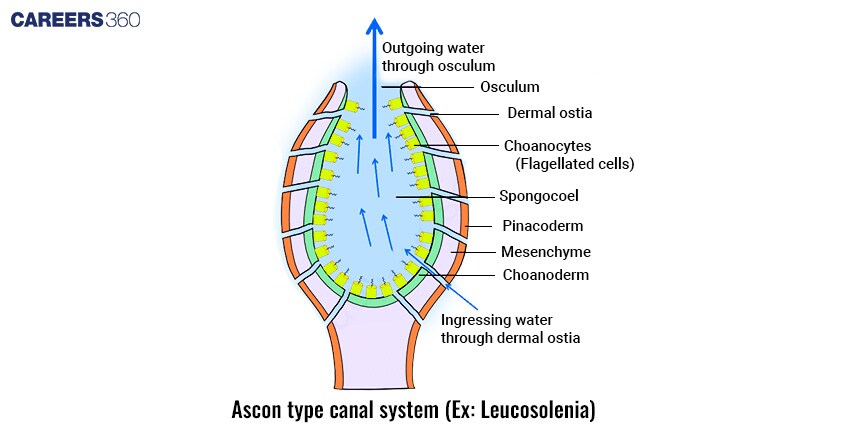
Syconoid Type
In this type, the body wall is folded into finger-like projections called the radial canals. These radial canals open into the spongocoel through apopyles.
The incurrent canals made up of Ostia are connected to the radial canals through prosopyles.
The route of water can be represented as dermal pores → incurrent canals → radial canals → internal ostia (apopyles) → spongocoeL → osculum → out.
For example, Scypha, Grantia etc.
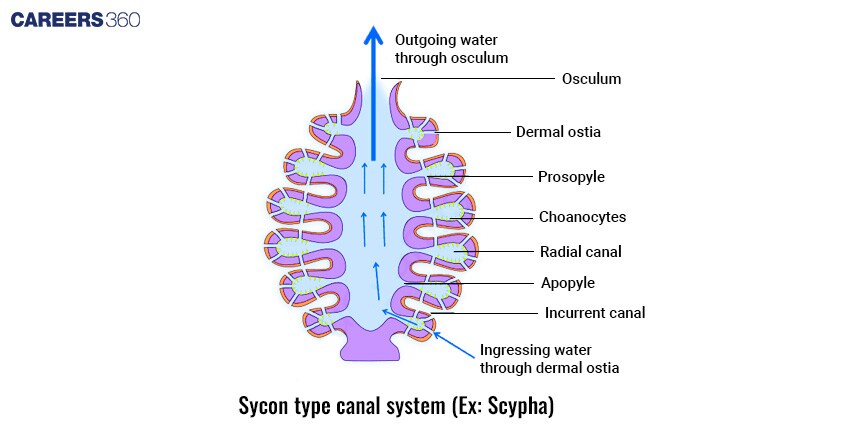
Leuconoid Type
It is characterised by highly folded thick walls such that the spongocoel is reduced to a large extent.
The folds occur in the form of chambers.
The route of water can be represented as dermal ostia → incurrent canals → flagellated chambers → excurrent canals → larger channels → oscula → out.
For example, Spongilla.
Also Read:
Recommended Video on Phylum Porifera
Frequently Asked Questions (FAQs)
The Porifera include simple, multicellular animals with porous bodies. They lack true tissues and organs and are to a great extent filter feeders.
Examples include Spongilla- freshwater sponge, Euspongia - bath sponge, Clathrina - calcareous sponge, and Euplectella - Venus' flower basket.
The three main classes of sponges are Calcarea, the calcareous sponges; Demospongiae, the most diverse group; and Hexactinellida, the glass sponges.
Sponges help regulate the quality of water, recycle nutrients, and provide a habitat for many marine organisms, which in turn produce biodiversity to ecosystem stability.
Sponges have spicules, either silica or calcium carbonate, together with tougher fibres of spongin that give strength and protection.
